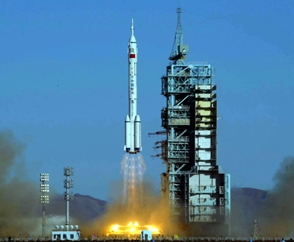Shenzhou, the name assigned to the spacecraft of China's space program, has already made a worldwide impression with 6 successful blastoffs, and Shenzhou VII is to be launched within this month.
Glorious course
 |
|
China's first manned spaceship, Shenzhou V, blasted off into space?on October 15, 2003. |
China's Manned Space Program was formally approved in 1992, and three key technical problems were overcome in the next 7 years.
On November 20, 1999 China's first unmanned spacecraft, Shenzhou I, marked the country's first great breakthrough in space exploration with a successful launch.
In the following three years, test flights of unmanned Shenzhou II, Shenzhou III, and Shenzhou IV were successively carried out. But Wang Yongzhi, the first chief designer of the Manned Space Program, said that "successful launch does not equal technological maturity – to catch up with other developed countries, we must progress in technology with a Chinese imprint."
On October 15, 2003 the trouble-free blastoff of Shenzhou V made China the third country in the world with the capacity to carry out independent manned space activities. His historic space trip made Yang Liwei a world-recognized "taikonaut".
On October 12, 2005 Shenzhou VI sent two astronauts, Fei Junlong and Nie Haisheng, into space to spend 115 hours there and perform China's first manual scientific experiments in space.
Stories behind the program
The launch site located in the northwest Gobi has witnessed not only the 6 successful launches of Shenzhou Spacecraft, but also the stories behind the success.
|

|
|
?Astronauts for China's Second Manned Space Mission |
Shenzhou I was originally a test spacecraft; its launch was therefore extremely risky.
On the eve of the Shenzhou II launch, the rocket was damaged; in a tense atmosphere the required repair work was carried out in an orderly way.
On the fourth day after Shenzhou III arrived at the launch site, a malfunction was discovered in a contact in one of the cabin sockets. The launch was delayed on safety grounds.
Before the launch of Shenzhou IV, continuous low temperatures led to the rocket being protected with more than 200 quilts.
In the last ground test of Shenzhou V, the buffer mechanism of the seat in the return module failed to perform according to the specification. Scientists solved the problem within only 70 days which would normally have required six months.
Heavy snow fell on the Shenzhou VI launch site in the early morning of October 12, 2005. But forecasters' accurate calculations determined a suitable time for the launch.
Bright future
These six remarkable space flights have produced tremendous benefits for the whole nation: some basic industries have been improved, and elements of space technology have been applied to industries like communication and food, thus influencing our daily life. A team of talented young astronauts, carrying the hopes of China's future in space, is growing towards maturity.
(China.org.cn September 10, 2008)